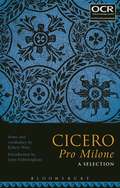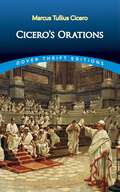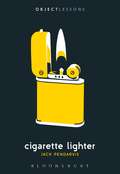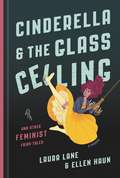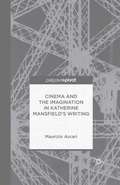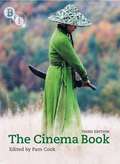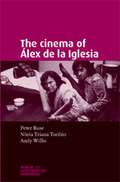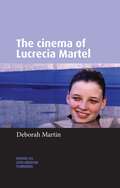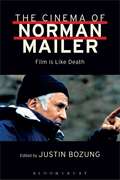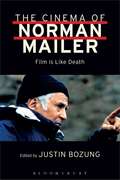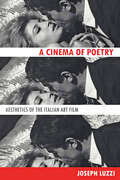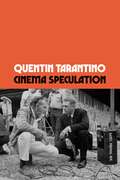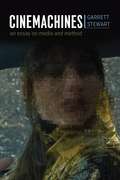- Table View
- List View
Cicero Pro Milone: A Selection
by Robert West Lynn FotheringhamThis is the OCR-endorsed publication from Bloomsbury for the Latin AS and A-Level (Group 1) prescription of Cicero's pro Milone sections 24–32, 34–35 and 43–52, and the A-Level (Group 2) prescription of sections 53–64 (to defendere) and 72–80, giving full Latin text, commentary and vocabulary, with a detailed introduction that also covers the prescribed text to be read in English for A Level.The death of Publius Clodius and the prosecution of Milo for his murder came at a critical point in the history of the late Republic, with Civil War and the collapse of the Republic only three years away. In his passionate defence of Milo, Cicero pleads for the rule of law as a vital counterweight to the anarchy that the gangs of Clodius, and Milo, had created. The published speech was regarded as a masterpiece of oratory in its own time, and is still held to be one of his finest compositions and a model for the presentation of such a defence.
Cicero Pro Milone: A Selection
by Robert West Lynn FotheringhamThis is the OCR-endorsed publication from Bloomsbury for the Latin AS and A-Level (Group 1) prescription of Cicero's pro Milone sections 24–32, 34–35 and 43–52, and the A-Level (Group 2) prescription of sections 53–64 (to defendere) and 72–80, giving full Latin text, commentary and vocabulary, with a detailed introduction that also covers the prescribed text to be read in English for A Level.The death of Publius Clodius and the prosecution of Milo for his murder came at a critical point in the history of the late Republic, with Civil War and the collapse of the Republic only three years away. In his passionate defence of Milo, Cicero pleads for the rule of law as a vital counterweight to the anarchy that the gangs of Clodius, and Milo, had created. The published speech was regarded as a masterpiece of oratory in its own time, and is still held to be one of his finest compositions and a model for the presentation of such a defence.
Cicero's Orations: In Catilinam I-iv, Pro Caelio, Pro Milone, Pro Archia (Dover Thrift Editions)
by Marcus Tullius Cicero Charles Duke YongeThe greatest orator of the late Roman Republic, Marcus Tullius Cicero (106–43 B.C.), influenced the course of European letters for centuries after his death. Through his writings, Renaissance and Enlightenment scholars encountered the riches of Classical rhetoric and philosophy. The elegance of his style, his skill and erudition, his worldly wisdom, and his profound humanity made Cicero a model for latter-day thinkers and keep his works ever relevant. This collection presents examples of rhetoric from throughout the ancient Roman's illustrious career. Selections include a series of famous speeches delivered during Cicero's term as consul which thwarted the Catiline conspiracy to overthrow the Republic — but led to his own prosecution and exile. The compilation concludes with the bold orations delivered in defiance of Marc Anthony, which sealed Cicero's doom.
"Cider with Rosie" by Laurie Lee (Master Guides)
by Brian TarbittOne of a series of books offering close textual analysis of the major works of English literature. The book contains a summary and commentary together with an anlysis of a specimen passage for style, a discussion of themes and critical features and a section on the writer's life.
Cigarette Lighter (Object Lessons)
by Jack PendarvisObject Lessons is a series of short, beautifully designed books about the hidden lives of ordinary things. Smokers, survivalists, teenagers, collectors…. The cigarette lighter is a charged, complex, yet often entirely disposable object that moves across these various groups of people, acquiring and emitting different meanings while always supplying its primary function, that of ignition. While the lighter may seem at first a niche object-only for old fashioned cigarette smokers-in this book Jack Pendarvis explodes the lighter as something with deep history, as something with quirky episodes in cultural contexts, and as something that dances with wide ranging taboos and traditions. Pendarvis shows how the lighter tarries with the cheapest ends of consumer culture as much as it displays more profound dramas of human survival, technological advances, and aesthetics.Object Lessons is published in partnership with an essay series in the The Atlantic.
Cigarette Lighter (Object Lessons)
by Jack PendarvisObject Lessons is a series of short, beautifully designed books about the hidden lives of ordinary things. Smokers, survivalists, teenagers, collectors…. The cigarette lighter is a charged, complex, yet often entirely disposable object that moves across these various groups of people, acquiring and emitting different meanings while always supplying its primary function, that of ignition. While the lighter may seem at first a niche object-only for old fashioned cigarette smokers-in this book Jack Pendarvis explodes the lighter as something with deep history, as something with quirky episodes in cultural contexts, and as something that dances with wide ranging taboos and traditions. Pendarvis shows how the lighter tarries with the cheapest ends of consumer culture as much as it displays more profound dramas of human survival, technological advances, and aesthetics.Object Lessons is published in partnership with an essay series in the The Atlantic.
Cinderella and the Glass Ceiling: And Other Feminist Fairy Tales
by Laura Lane Ellen Haunp.p1 {margin: 0.0px 0.0px 0.0px 0.0px; font: 13.3px Times} This wickedly wise (and wisecracking) parody of classic fairy tales redefines happily ever after for the modern feminist era.You know what? It's super creepy to kiss a woman who is unconscious. And you know what else? The way out of poverty isn't by marrying a rich dude -- or by wearing fragile footwear, for that matter. And while we're at it, why is the only woman who lives with seven men expected to do the cooking, cleaning, and laundry?Fairytales need a reboot, and comedy queens Laura Lane and Ellen Haun are the women to do it. In Cinderella and the Glass Ceiling, they offer a rollicking parody of classic (read: patriarchal) tales that turns sweet, submissive princesses into women who are perfectly capable of being the heroes of their own stories. Mulan climbs the ranks in the army but wages a different war when she finds out she's getting paid less than her fellow male captains, Wendy learns never to trust a man-boy stalking her window, Sleeping Beauty's prince gets a lesson in consent, and more.Busting with laugh-out-loud, razor-sharp twists to these outdated tales, Cinderella and the Glass Ceiling is fun, magical, necessary, and totally woke.
Cinema and the Imagination in Katherine Mansfield's Writing
by M. AscariUsing silent cinema as a critical lens enables us to reassess Katherine Mansfield's entire literary career. Starting from the awareness that innovation in literature is often the outcome of hybridisation, this book discusses not only a single case study, but also the intermedia exchanges in which literary modernism at large is rooted.
The Cinema Book (3rd edition) (PDF)
by Pam CookThird edition. Fully revised, this is a bestselling, must-have textbook for all students of cinema. Taking stock of the many recent exciting developments in the field whilst retaining the historical coverage and depth of previous editions, the text is supported by over 250 illustrations. Includes thorough analysis and relevent information on more than 350 films.
The cinema of Álex de la Iglesia (Spanish and Latin-American Filmmakers)
by Peter Buse Andy Willis Nuria Triana-ToribioÁlex de la Iglesia, initially championed by Pedro Almodóvar, and at one time the enfant terrible of Spanish film, still makes film critics nervous. The director of some of the most important films of the Post-Franco era – Acción mutante, El día de la bestia, Muertos de risa – receives here the first full length study of his work. Breaking away from the pious tradition of acclaiming art-house auteurs, The cinema of Álex de la Iglesia tackles a new sort of beast: the popular auteur, who brings the provocation of the avant-garde to popular genres such as horror and comedy. This book brings together Anglo-American film theory, an exploration of the legal and economic history of Spanish audio-visual culture, a comprehensive knowledge of Spanish cultural forms and traditions (esperpento, sainete costumbrista) with a detailed textual analysis of all of Álex de la Iglesia’s seven feature films.
The cinema of Álex de la Iglesia (Spanish and Latin-American Filmmakers)
by Peter Buse Andy Willis Nuria Triana-ToribioÁlex de la Iglesia, initially championed by Pedro Almodóvar, and at one time the enfant terrible of Spanish film, still makes film critics nervous. The director of some of the most important films of the Post-Franco era – Acción mutante, El día de la bestia, Muertos de risa – receives here the first full length study of his work. Breaking away from the pious tradition of acclaiming art-house auteurs, The cinema of Álex de la Iglesia tackles a new sort of beast: the popular auteur, who brings the provocation of the avant-garde to popular genres such as horror and comedy. This book brings together Anglo-American film theory, an exploration of the legal and economic history of Spanish audio-visual culture, a comprehensive knowledge of Spanish cultural forms and traditions (esperpento, sainete costumbrista) with a detailed textual analysis of all of Álex de la Iglesia’s seven feature films.
The cinema of Lucrecia Martel (Spanish And Latin American Filmmakers Mup Ser.)
by Deborah MartinThe cinema of Lucrecia Martel provides a comprehensive analysis of the work of the acclaimed Argentine director, whose elusive and elliptical feature films have garnered worldwide recognition since her 2001 debut La ciénaga. The book situates Martel's features and unstudied short films in relation to trends in recent national and international filmmaking. This volume considers existing critical work on Martel's oeuvre, and proposes new ways of understanding it, in particular through desire, the use of the child's perspective, and through the senses and perception. Martin also offers an analysis of the politics of Martel's films, showing how they can be understood as sites of transformation and possibility, develops queer approaches to Martel's films, and shows how they offer new forms of cinematic pleasure. The cinema of Lucrecia Martel combines traditional plot and gaze analysis with an understanding of film as a material object, to explore the films' sensory experiments and their challenges to dominant cinematic forms.
The cinema of Lucrecia Martel (PDF)
by Deborah MartinThe cinema of Lucrecia Martel provides a comprehensive analysis of the work of the acclaimed Argentine director, whose elusive and elliptical feature films have garnered worldwide recognition since her 2001 debut La ciénaga. The book situates Martel's features and unstudied short films in relation to trends in recent national and international filmmaking. This volume considers existing critical work on Martel's oeuvre, and proposes new ways of understanding it, in particular through desire, the use of the child's perspective, and through the senses and perception. Martin also offers an analysis of the politics of Martel's films, showing how they can be understood as sites of transformation and possibility, develops queer approaches to Martel's films, and shows how they offer new forms of cinematic pleasure. The cinema of Lucrecia Martel combines traditional plot and gaze analysis with an understanding of film as a material object, to explore the films' sensory experiments and their challenges to dominant cinematic forms.
The Cinema of Norman Mailer: Film is Like Death
by Norman Mailer Justin BozungThe Cinema of Norman Mailer: Film is Like Death not only examines the enfant terrible writer's thoughts on cinema, but also features interviews with Norman Mailer himself. The Cinema of Norman Mailer also explores Mailer's cinema through previously published and newly commissioned essays written by an array of film and literary scholars, enthusiasts, and those with a personal, philosophical connection to Mailer. This volume discusses the National Book Award and Pulitzer Prize-winning author and filmmaker's six films created during the years of 1947 and 1987, and contends to show how Mailer's films can be best read as cinematic delineations that visually represent many of the writer's metaphysical and ontological concerns and ideas that appear in his texts from the 1950s until his passing in 2007. By re-examining Mailer's cinema through these new perspectives, one may be awarded not just a deeper understanding of Mailer's desire to make films, but also find a new, alternative vision of Mailer himself. Norman Mailer was not just a writer, but more: he was one of the most influential Postmodern artists of the twentieth century with deep roots in the cinema. He allowed the cinema to not only influence his aesthetic approach, but sanctioned it as his easiest-crafted analogy for exploring sociological imagination in his writing. Mailer once suggested, "Film is legitimately more interesting than books..." and with that in mind, readers of Norman Mailer might begin to rethink his oeuvre through the viewfinder of the film medium, as he was equally as passionate about working within cinema as he was about literature itself.
The Cinema of Norman Mailer: Film is Like Death
by Norman Mailer Justin BozungThe Cinema of Norman Mailer: Film is Like Death not only examines the enfant terrible writer's thoughts on cinema, but also features interviews with Norman Mailer himself. The Cinema of Norman Mailer also explores Mailer's cinema through previously published and newly commissioned essays written by an array of film and literary scholars, enthusiasts, and those with a personal, philosophical connection to Mailer. This volume discusses the National Book Award and Pulitzer Prize-winning author and filmmaker's six films created during the years of 1947 and 1987, and contends to show how Mailer's films can be best read as cinematic delineations that visually represent many of the writer's metaphysical and ontological concerns and ideas that appear in his texts from the 1950s until his passing in 2007. By re-examining Mailer's cinema through these new perspectives, one may be awarded not just a deeper understanding of Mailer's desire to make films, but also find a new, alternative vision of Mailer himself. Norman Mailer was not just a writer, but more: he was one of the most influential Postmodern artists of the twentieth century with deep roots in the cinema. He allowed the cinema to not only influence his aesthetic approach, but sanctioned it as his easiest-crafted analogy for exploring sociological imagination in his writing. Mailer once suggested, "Film is legitimately more interesting than books..." and with that in mind, readers of Norman Mailer might begin to rethink his oeuvre through the viewfinder of the film medium, as he was equally as passionate about working within cinema as he was about literature itself.
A Cinema of Poetry: Aesthetics of the Italian Art Film (PDF)
by Joseph LuzziA Cinema of Poetry brings Italian film studies into dialogue with fields outside its usual purview by showing how films can contribute to our understanding of aesthetic questions that stretch back to Homer. Joseph Luzzi considers the relation between film and literature, especially the cinematic adaptation of literary sources and, more generally, the fields of rhetoric, media studies, and modern Italian culture.The book balances theoretical inquiry with close readings of films by the masters of Italian cinema: Roberto Rossellini, Vittorio De Sica, Luchino Visconti, Michelangelo Antonioni, Federico Fellini, Pier Paolo Pasolini, Bernardo Bertolucci, and others. Luzzi's study is the first to show how Italian filmmakers address such crucial aesthetic issues as the nature of the chorus, the relation between symbol and allegory, the literary prehistory of montage, and the place of poetry in cinematic expression�what Pasolini called the "cinema of poetry." While Luzzi establishes how certain qualities of film�its link with technological processes, capacity for mass distribution, synthetic virtues (and vices) as the so-called total art�have reshaped centuries-long debates, A Cinema of Poetry also explores what is specific to the Italian art film and, more broadly, Italian cinematic history. In other words, what makes this version of the art film recognizably "Italian"?
A Cinema of Poetry: Aesthetics of the Italian Art Film
by Joseph LuzziA Cinema of Poetry brings Italian film studies into dialogue with fields outside its usual purview by showing how films can contribute to our understanding of aesthetic questions that stretch back to Homer. Joseph Luzzi considers the relation between film and literature, especially the cinematic adaptation of literary sources and, more generally, the fields of rhetoric, media studies, and modern Italian culture.The book balances theoretical inquiry with close readings of films by the masters of Italian cinema: Roberto Rossellini, Vittorio De Sica, Luchino Visconti, Michelangelo Antonioni, Federico Fellini, Pier Paolo Pasolini, Bernardo Bertolucci, and others. Luzzi's study is the first to show how Italian filmmakers address such crucial aesthetic issues as the nature of the chorus, the relation between symbol and allegory, the literary prehistory of montage, and the place of poetry in cinematic expression;¢;‚¬;€?what Pasolini called the "cinema of poetry." While Luzzi establishes how certain qualities of film;¢;‚¬;€?its link with technological processes, capacity for mass distribution, synthetic virtues (and vices) as the so-called total art;¢;‚¬;€?have reshaped centuries-long debates, A Cinema of Poetry also explores what is specific to the Italian art film and, more broadly, Italian cinematic history. In other words, what makes this version of the art film recognizably "Italian"?
Cinema Speculation
by Quentin TarantinoA unique cocktail of personal memoir, cultural criticism and Hollywood history by the one and only Quentin Tarantino.The long-awaited first work of nonfiction from the author of the number one New York Times bestselling Once Upon a Time in Hollywood: a deliriously entertaining, wickedly intelligent cinema book as unique and creative as anything by Quentin Tarantino.In addition to being among the most celebrated of contemporary filmmakers, Quentin Tarantino is possibly the most joyously infectious movie lover alive. For years he has touted in interviews his eventual turn to writing books about films. Now, with CINEMA SPECULATION, the time has come, and the results are everything his passionate fans - and all movie lovers - could have hoped for. Organized around key American films from the 1970s, all of which he first saw as a young moviegoer at the time, this book is as intellectually rigorous and insightful as it is rollicking and entertaining. At once film criticism, film theory, a feat of reporting, and wonderful personal history, it is all written in the singular voice recognizable immediately as QT's and with the rare perspective about cinema possible only from one of the greatest practitioners of the artform ever.
Cinemachines: An Essay on Media and Method
by Garrett StewartThe hero stands on stage in high-definition 3-D while doubled on a crude pixel screen in Billy Lynn’s Long Halftime Walk. Alien ships leave Earth by dissolving at the conclusion of Arrival. An illusory death spiral in Vertigo transitions abruptly to a studio set, jolting the spectator. These are a few of the startling visual moments that Garrett Stewart examines in Cinemachines, a compelling, powerful, and witty book about the cultural and mechanical apparatuses that underlie modern cinema. Engaging in fresh ways with revelatory special effects in the history of cinematic storytelling—from Buster Keaton’s breaching of the film screen in Sherlock Jr. to the pixel disintegration of a remotely projected hologram in Blade Runner 2049—Stewart’s book puts unprecedented emphasis on technique in moving image narrative. Complicating and revising the discourse on historical screen processes, Cinemachines will be crucial reading for anyone interested in the evolution of the movies from a celluloid to a digital medium.
Cinemachines: An Essay on Media and Method
by Garrett StewartThe hero stands on stage in high-definition 3-D while doubled on a crude pixel screen in Billy Lynn’s Long Halftime Walk. Alien ships leave Earth by dissolving at the conclusion of Arrival. An illusory death spiral in Vertigo transitions abruptly to a studio set, jolting the spectator. These are a few of the startling visual moments that Garrett Stewart examines in Cinemachines, a compelling, powerful, and witty book about the cultural and mechanical apparatuses that underlie modern cinema. Engaging in fresh ways with revelatory special effects in the history of cinematic storytelling—from Buster Keaton’s breaching of the film screen in Sherlock Jr. to the pixel disintegration of a remotely projected hologram in Blade Runner 2049—Stewart’s book puts unprecedented emphasis on technique in moving image narrative. Complicating and revising the discourse on historical screen processes, Cinemachines will be crucial reading for anyone interested in the evolution of the movies from a celluloid to a digital medium.
Cinemachines: An Essay on Media and Method
by Garrett StewartThe hero stands on stage in high-definition 3-D while doubled on a crude pixel screen in Billy Lynn’s Long Halftime Walk. Alien ships leave Earth by dissolving at the conclusion of Arrival. An illusory death spiral in Vertigo transitions abruptly to a studio set, jolting the spectator. These are a few of the startling visual moments that Garrett Stewart examines in Cinemachines, a compelling, powerful, and witty book about the cultural and mechanical apparatuses that underlie modern cinema. Engaging in fresh ways with revelatory special effects in the history of cinematic storytelling—from Buster Keaton’s breaching of the film screen in Sherlock Jr. to the pixel disintegration of a remotely projected hologram in Blade Runner 2049—Stewart’s book puts unprecedented emphasis on technique in moving image narrative. Complicating and revising the discourse on historical screen processes, Cinemachines will be crucial reading for anyone interested in the evolution of the movies from a celluloid to a digital medium.
Cinemachines: An Essay on Media and Method
by Garrett StewartThe hero stands on stage in high-definition 3-D while doubled on a crude pixel screen in Billy Lynn’s Long Halftime Walk. Alien ships leave Earth by dissolving at the conclusion of Arrival. An illusory death spiral in Vertigo transitions abruptly to a studio set, jolting the spectator. These are a few of the startling visual moments that Garrett Stewart examines in Cinemachines, a compelling, powerful, and witty book about the cultural and mechanical apparatuses that underlie modern cinema. Engaging in fresh ways with revelatory special effects in the history of cinematic storytelling—from Buster Keaton’s breaching of the film screen in Sherlock Jr. to the pixel disintegration of a remotely projected hologram in Blade Runner 2049—Stewart’s book puts unprecedented emphasis on technique in moving image narrative. Complicating and revising the discourse on historical screen processes, Cinemachines will be crucial reading for anyone interested in the evolution of the movies from a celluloid to a digital medium.
Cinemachines: An Essay on Media and Method
by Garrett StewartThe hero stands on stage in high-definition 3-D while doubled on a crude pixel screen in Billy Lynn’s Long Halftime Walk. Alien ships leave Earth by dissolving at the conclusion of Arrival. An illusory death spiral in Vertigo transitions abruptly to a studio set, jolting the spectator. These are a few of the startling visual moments that Garrett Stewart examines in Cinemachines, a compelling, powerful, and witty book about the cultural and mechanical apparatuses that underlie modern cinema. Engaging in fresh ways with revelatory special effects in the history of cinematic storytelling—from Buster Keaton’s breaching of the film screen in Sherlock Jr. to the pixel disintegration of a remotely projected hologram in Blade Runner 2049—Stewart’s book puts unprecedented emphasis on technique in moving image narrative. Complicating and revising the discourse on historical screen processes, Cinemachines will be crucial reading for anyone interested in the evolution of the movies from a celluloid to a digital medium.
Cinemachines: An Essay on Media and Method
by Garrett StewartThe hero stands on stage in high-definition 3-D while doubled on a crude pixel screen in Billy Lynn’s Long Halftime Walk. Alien ships leave Earth by dissolving at the conclusion of Arrival. An illusory death spiral in Vertigo transitions abruptly to a studio set, jolting the spectator. These are a few of the startling visual moments that Garrett Stewart examines in Cinemachines, a compelling, powerful, and witty book about the cultural and mechanical apparatuses that underlie modern cinema. Engaging in fresh ways with revelatory special effects in the history of cinematic storytelling—from Buster Keaton’s breaching of the film screen in Sherlock Jr. to the pixel disintegration of a remotely projected hologram in Blade Runner 2049—Stewart’s book puts unprecedented emphasis on technique in moving image narrative. Complicating and revising the discourse on historical screen processes, Cinemachines will be crucial reading for anyone interested in the evolution of the movies from a celluloid to a digital medium.
